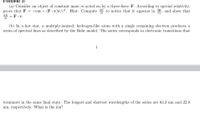Question

Transcribed Image Text:**Problem 3:**
(a) Consider an object of constant mass \( m \) acted on by a three-force \( \mathbf{F} \). According to special relativity, prove that \( \mathbf{F} = \gamma m \mathbf{a} + (\mathbf{F} \cdot \mathbf{v}) \mathbf{v}/c^2 \). Hint: Compute \( \frac{dE}{dt} \) to notice that it appears in \( \frac{dp}{dt} \), and show that \( \frac{dE}{dt} = \mathbf{F} \cdot \mathbf{v} \).
(b) In a hot star, a multiply-ionized, hydrogen-like atom with a single remaining electron produces a series of spectral lines as described by the Bohr model. The series corresponds to electronic transitions that terminate in the same final state. The longest and shortest wavelengths of the series are 63.3 nm and 22.8 nm, respectively. What is the ion?
Expert Solution
This question has been solved!
Explore an expertly crafted, step-by-step solution for a thorough understanding of key concepts.
This is a popular solution
Trending nowThis is a popular solution!
Step by stepSolved in 4 steps with 1 images

Knowledge Booster
Similar questions
- Using partial derivatives, calculate the propagated uncertainty in the mass in the following case: given the centripetal force Fc = (20.0 ± 0.5) N, the angular velocity w = (29.2 ± 0.3) rad/s, and the radius R = (0.12 ± 0.01) m get the mass value,m = Fc / (w2R). Express the result in the form m = m + Δm ----------------------------------- THAT'S THE QUESTION ASKED, see the image for the answer. Also have a look at the second image, the blue one. --------------------------------------------------------------- Explain what is the 1/m just after the equals sign at the second line of the answer. Also, explain why the answer does not use the square root just like the blue image, of if it is using it. Then, say in which case should I use the partial derivate to calculate the uncertainty.arrow_forwardConsider an ultrahigh-energy cosmic ray entering the Earth’s atmosphere (some have energies approaching a joule).Construct a problem in which you calculate the energy of the particle based on the number of particles in an observed cosmic ray shower. Among the things to consider are the average mass of the shower particles, the average number per square meter, and the extent (number of square meters covered) of the shower. Express the energy in eV and joules.arrow_forwardTwo stars, both of which behave like ideal blackbodies, radiate the same total energy per second. The cooler one has a surface temperature T and 4.0 times the diameter of the hotter star. What is the temperature of the hotter star in terms of T? (Just write the result)arrow_forward
- Figure 1 of 1 > Energy (J) 4. 3. 2- 1- 1,2-1 +. -1 -21 K, + U, +Wt= K, + U, + AE %3D ext |||arrow_forwardIf the human body is well approximated by a black body with tem- perature T = 310◦ K (98.6◦ F). At what wavelength (λ) do we emit the most energy (λmax)? How much energy per area (flux) do we emit? Remember the value of the Stefan-Boltzmann constant is σ = 5.67 × 10−5erg/(cm2K4s1). What kind of radiation (region of the electromagnetic spectrum) do we emit most of?arrow_forward
arrow_back_ios
arrow_forward_ios